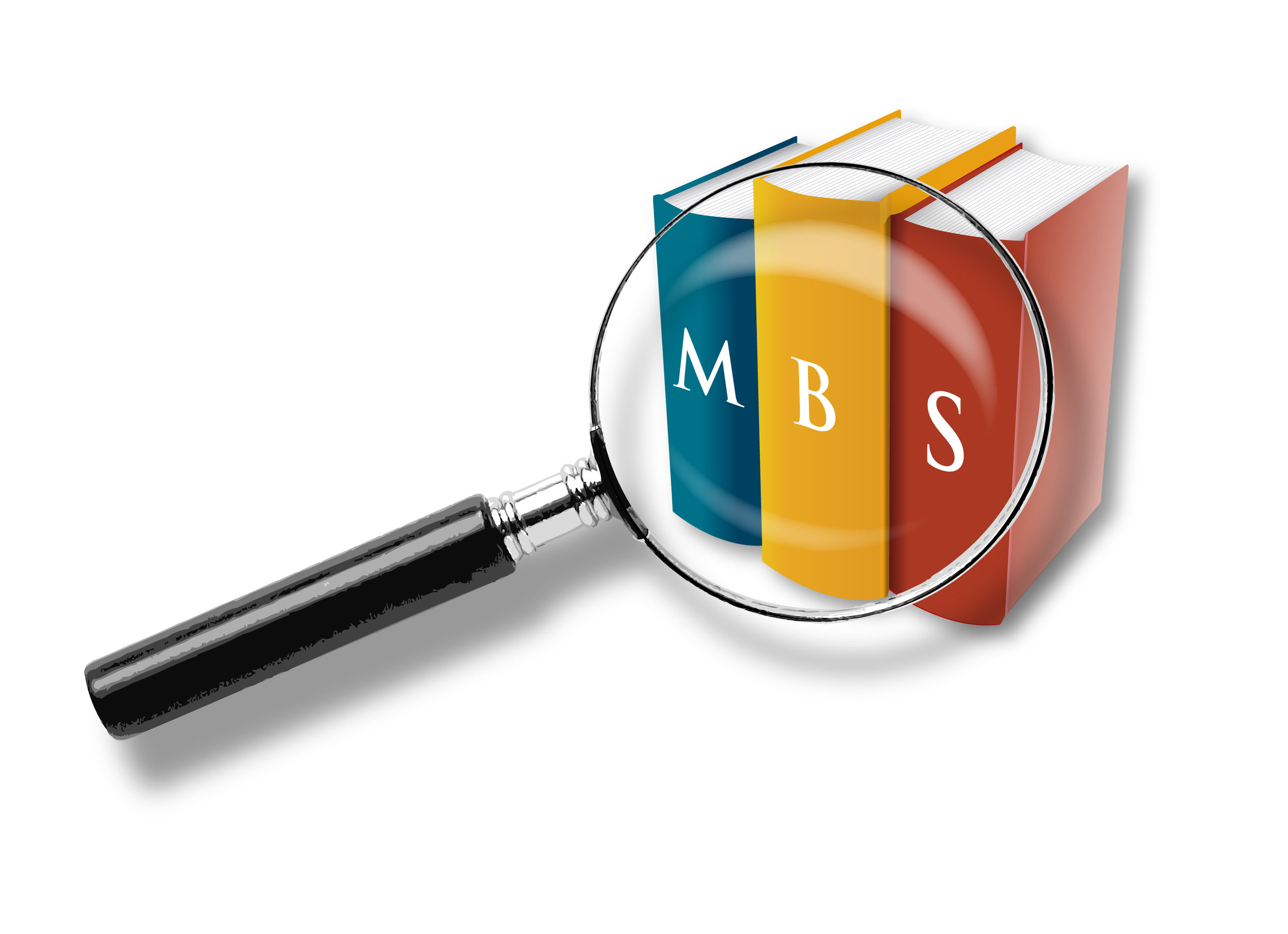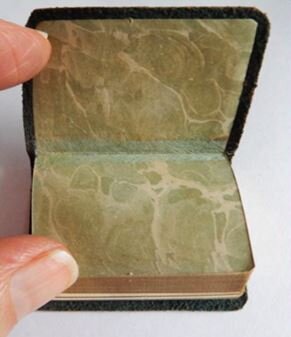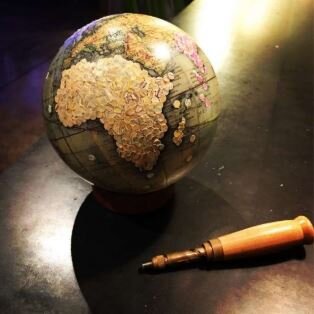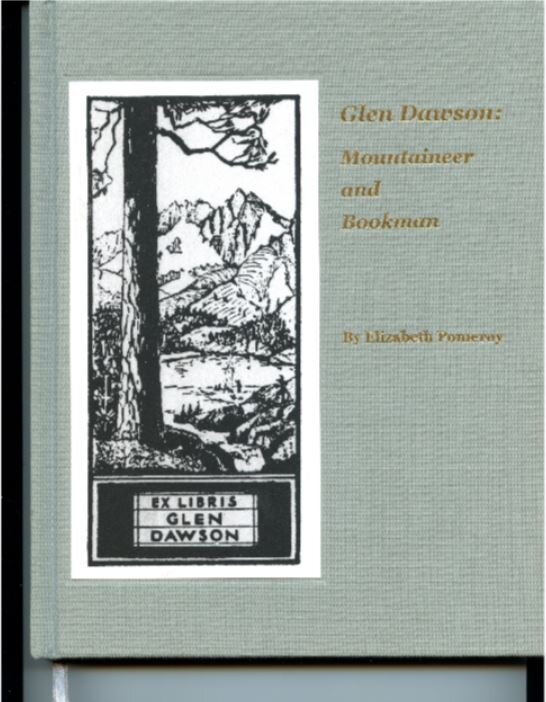MBS Member’s Articles
Sharing information, ideas and thoughts relating to miniature books is what the Miniature Book Society is all about. Below you will find articles of various topics written by our members.
MBS member Deborah Evertts, Virginia, USA
Quality Materials Are Key For Repairing Miniature Books.
The repair of miniature books requires special materials. A good example of which, is the very thin and exceptionally strong Tenhgu-jo tissue. The strength of this very thin tissue comes from the length and quality of its fibers. Having said this, it is important to stress that it is a difficult material to use because it tends to disintegrate when paste is brushed onto it. In order to overcome this problem, first brush your paste onto the area to be strengthened and only then carefully place the tissue onto it.
Book Joints
For repairs to book joints, I cut pieces of the Tengu-jo tissue to the height of the end-leaves and approximately ⅜ of an inch wide. Note that for best rests, the tissue is severed with the point of a needle, which produces a soft edge and allows it to be gently pulled apart. I’ve found that soft-edged tissue tends to discourage further breakage of the old paper on which I am working. With joint repairs it is important to place the book on a stand. Then, while holding the board open with one hand, paste both sides of the joint with a thin starch paste and use tweezers to insert the folded strip of tissue. Then “spread” the fold by placing the tips of the tweezers in the middle of the “V” of tissue and gently opening them. At this point the Tengu-jo will instantly adhere. Then place a folded piece of polyester web (enclosing a strip of Mylar) into the fold, push the tissue into the joint with the Mylar and after closing the book, put a weight on it and let dry.
Headcaps
For headcaps, tiny pieces of tissue are placed on the already pasted area to be strengthened, gently rubbed down through a thin polyester web and finished with a Teflon folder directly onto the tissue. If the color is still not quite right, a Q-Tip dipped in a color rolled on newsprint until almost dry and then gently rolled over the repair will tone it done.
Displays that also protect.
Here are two solutions to the problem of getting miniature volumes out of their shelves without damaging them.
1. Philatelist’s tweezers with their highly polished, flat jaws will not hurt the bindings, however they do not open very wide so can only be used o n really small volumes.
2. For more substantial books, place a band of vellum around one volume on each shelf to serve as a pull tab.
Use a strip of thin paper to measure the book’s exact dimension. Make the tab by cutting a narrow strip of light weight vellum long enough to wrap round the book plus one inch. Transfer the exact dimension from the paper to the vellum, allowing an extra half inch at each end. Just a hair beyond where the exact dimension marks fall, cut half the way through the width of the vellum from opposites sides. Finish by punching a circle of holes in the vellum to decorate and soften the look of the ends. Wrap round the book and slip the cuts into one another. To take the book from the shelf, pull on the decorative tabs while restraining the adjacent books.
Working on all four of my Shakespeare sets, I have made boxes for the Bryce’s Illustrated Pocket Shakespeare in eight volumes and the 1825 Pickering set in green cloth, A thirty-seven volume, 2⅛” by 1⅜”, David Bryce set, dedicated to Ellen Terry is lucky enough to be house in a rotating bookcase. A second set of 1825 Pickering, bound in blue cloth, resides in its own upright wooden bookcase with a glass door. All the many bindings require restoration with the end-leaf joints or cloth headcaps needing strengthening.
MBS member Sarah Burnett-Moore, London, UK
My Favourite Bookmaking Tool...
...is a Japanese Screw Punch. Those of you who already own one will be familiar with the delights of this little analogue beauty. Unlike an Archimedes drill (also very satisfying to use), or a bench drill for the power tool enthusiasts, the screw punch makes a hole with a circular bit, meaning you can save the 0.5mm to 5mm “hole” that you have punched. It produces a very crisp edge to a hole, unlike a drill which tends to chew the edges a bit. It’s a must for cutting guide holes for slots, or taking a snick out of finely pared leather to turn a neater corner. It doesn’t require much practice to use, you just need to make sure it’s properly vertical and tangential to the material. Some practice is needed for precise hole placement.
The bits come in a variety of sizes and, when needed, are easily sharpened by punching a few times into aluminium kitchen foil. A quick word of warning, though: punch into a mat you don’t care about, or old greyboard, as the holes will not heal on your best mat. I use end grain wood (like a mini butcher’s block) as that gives a really neat edge without blunting the bits too quickly.
It can be used to make recesses for magnets, create rounded corners for windows, make holes for closures, and many more applications. Practical uses aside, what design project isn’t enhanced by the use of a few strategically placed dots? Make a hole and use a material of the same thickness in a contrasting colour. I make many things in addition to books and regularly use my screw punch for leatherwork, vinyl hot press, and paper cutting - because using a blade to make a round is, as we Brits would say, a total faff. I even use it for millinery as it’s easy to cut a hole through felt and replace with a different colour to make polka dots. It’s also great for making your own stencils or to cut through thinly rolled and cured polymer clay. Almost every craft class I go to I take my screw punch, unless it’s a fibre activity where the holes would end up fraying. The only things it doesn’t work on are wood, metal, rigid plastics, or anything brittle. I’m sure if I was a more creative cook I could find an application for tiny smoked salmon dots.
I am such a screw punch geek that I have made an old glasses case into a safe haven for it, complete with some stiff foam with cut holes to store the bits as they blunt quickly if you let them knock against each other. Even if I don’t need it if I can’t locate it my day is diminished. Woe betide anyone how misuses it and it’s the one tool I’m reluctant to lend. Like all tools, you get what you pay for and it’s worth investing in the best and looking after it, especially as the bits aren’t cheap.
A fun screw punch fact: the residual material from the ‘holes’ are known as chads. I save mine in those travel pill dispensers, labelled for size. Now what to do with them...I think I’ll embellish a vintage globe with all the chads from some paper I marbled.... Quite a bit of the world to go.... Pass the PVA!
Article reprinted with gracious permission of the author and the Miniature Book Society.
Copyright 2019 MBS. All rights reserved. www.mbs.org
SOMETHING SPECIAL!
November, 2019. The article above, written by Sarah, was requested for reprint by the Designer Bookbinders, London, United Kingdom, for their Newsletter. Congratulations Sarah!
MBS member: Jim Brogan, New Jersey, USA
THE SPIRIT OF A MINIATURE BOOK COLLECTOR, The Conclave Keepsake, March 2019
As members of the Miniature Book Society, we are collectors. Some of us collect letterpress books, some collect art books, some all type of books, and some collect keepsakes. A keepsake as defined by Webster’s as "something that you receive and keep to help you remember a person, place, or event: a memento or souvenir." A Conclave keepsake certainly fits that description in all categories.
The first MBS Conclave was held in 1983 and there are more than a few examples of the keepsakes that were exchanged at that conclave. Over the years, the exchange of keepsakes has grown in some years and not been as plentiful in other years. However, the practice continues to this day and there are always outstanding examples of the creativity of our members with each Conclave event.
I can remember the day that I arrived in San Diego to attend my first MBS Conclave in 2008. Seems like only yesterday that I arrived and opened up the unique bag of things that was given to me as part of the registration process. There were maps and various announcements and schedules of activities and menus, all the things that you expect at a professional conference. However, there were also included, in the collection, several keepsakes, those special things that some of the attendees provided as tokens of appreciation for each attendee.
With each subsequent Conclave, I always look forward to that special bag of special things, the keepsakes. Some are handmade, some large, some very small, some ornate, some less complex. However, the glue that each keepsake contains reflects the expressions and creativity of each provider and the amount of thought that is included in every one of the keepsakes. These, to me, are priceless.
I am sure that some of the members are fastidious collectors of the keepsakes from each conclave. There are members who spend a tremendous amount of time providing a keepsake and some require less time and materials. However, they are all treasures, a reflection of the event, the place, and the person who provided the keepsake.
MBS member: Elizabeth Pomery, California, USA
New Book About Glen Dawson: "A Life Conquering the Tallest Mountains and the Smallest Books”
"Is it even possible to say farewell to one such as Glen Dawson? Those words appeared after the death of Glen in 2016, in an MBS Newsletter. Those 103 years that Glen lived were packed with setting records climbing mountains, earning awards for bravery during war, building a business in books, and raising a family with Mary Helen. Oh! and those miniature books. One can't mention Glen Dawson without remembering those wonderful miniature books. When Glen turned 80, the MBS Newsletter ran a story “A Bookman Turns Eighty.” Part of that story best describes the man so many of us knew, loved, and remembered, admired, respected, revered, and constantly sought-out for his tremendous knowledge. His reputation as a bookman has been built on decades of assistance to those who share his love of books.
I am a member of MBS and have just completed a new biography: Glen Dawson: Mountaineer and Bookman, published by Sagest of Pasadena, 2019. It is a beautifully illustrated overview of Glen's life of accomplishments You can view more about the book at www.sagest.com. Should you have any questions please contact me at your convenience: (626) 791-7660.




